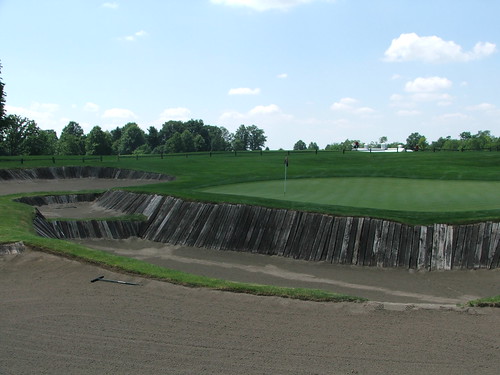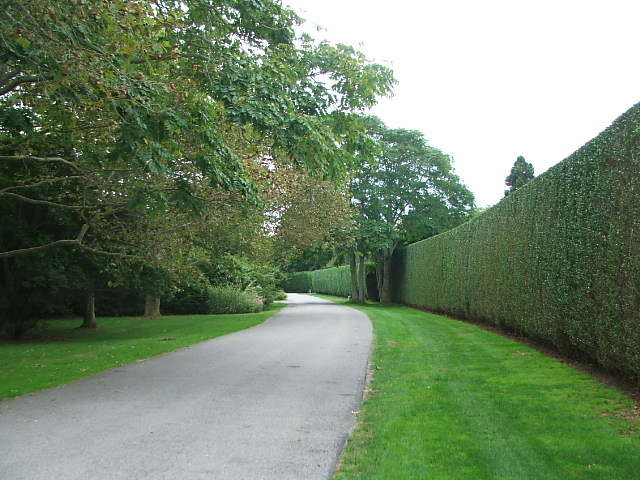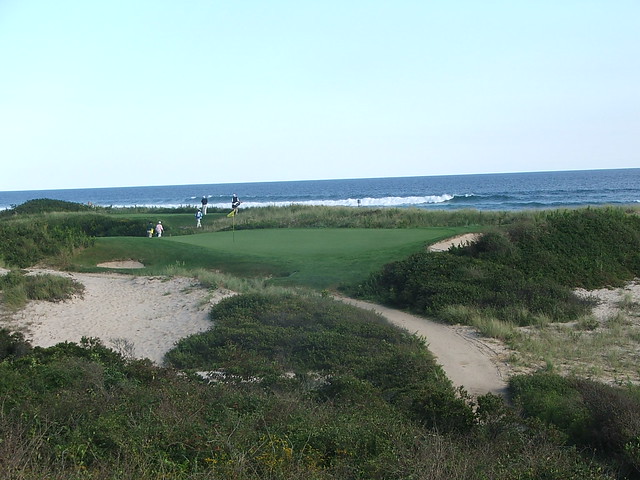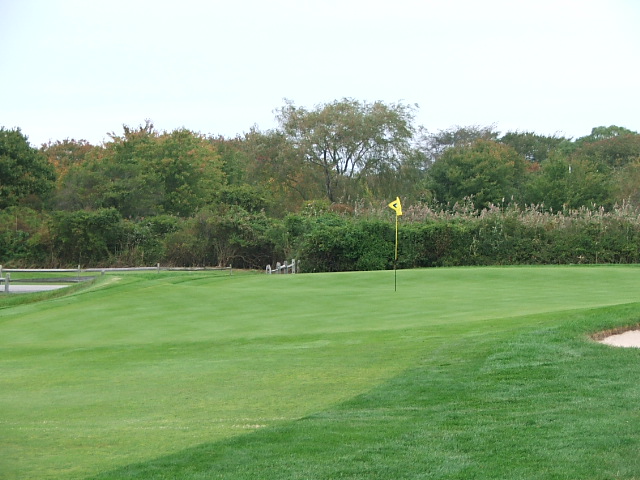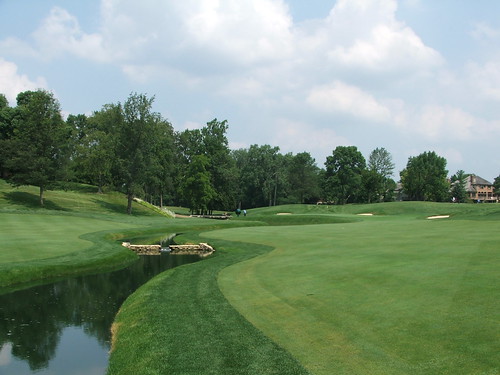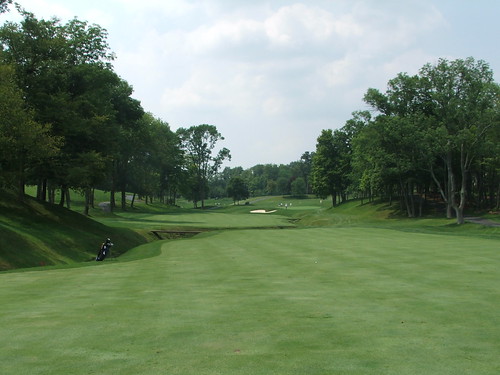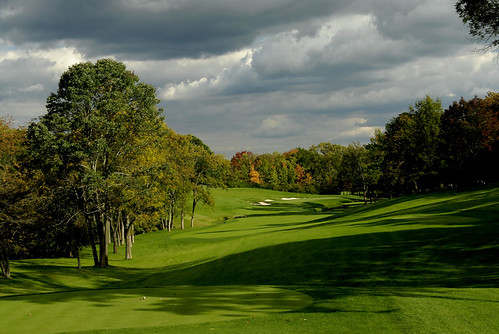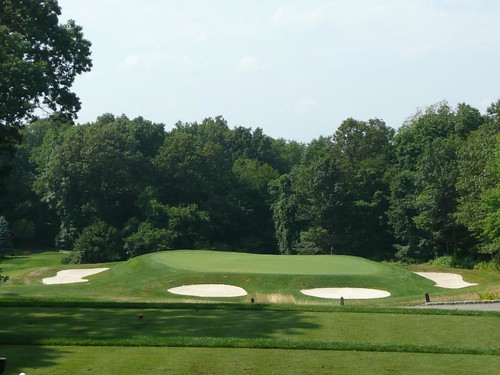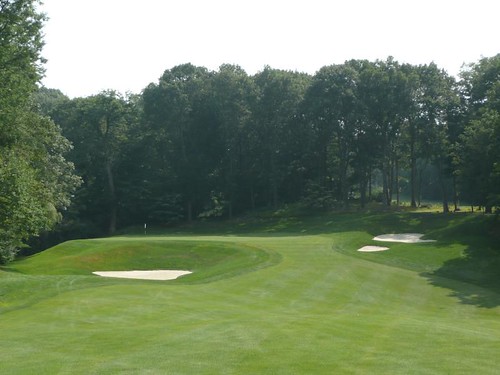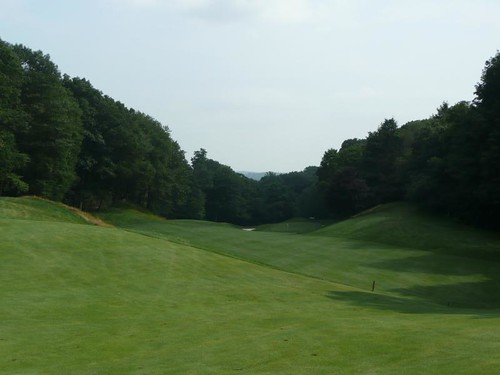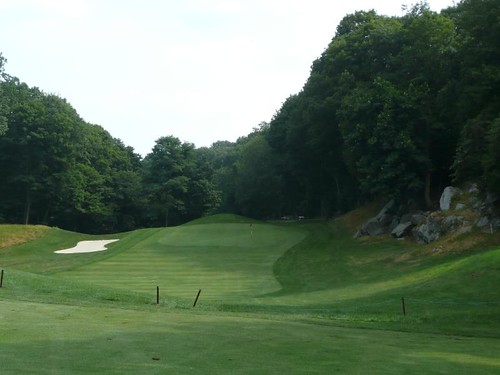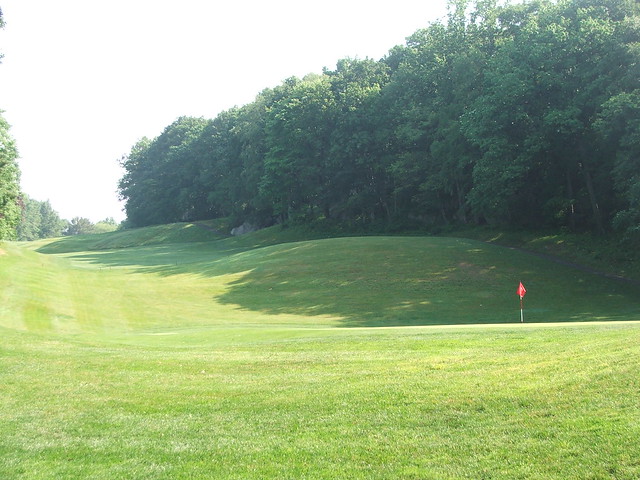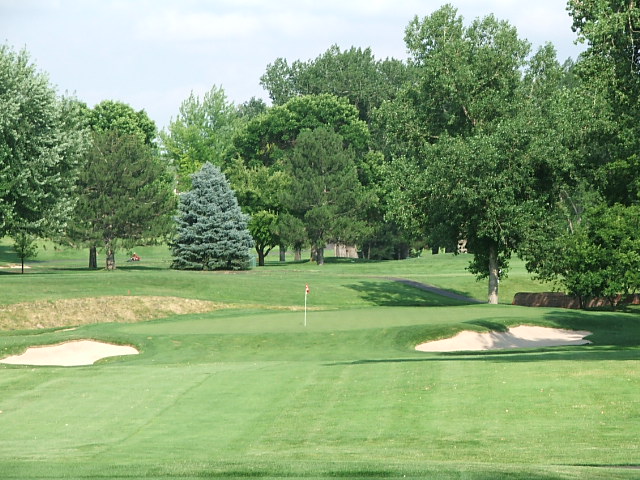Sunday, November 15, 2009
Tom Clasby: Golf Magazine Panelist of the Year
By Joe Passov, Senior Editor, Golf Magazine.
Call it a hobby, a passion, or even a quest. GOLF Magazine is fortunate to boast no fewer than 12 Panelists who have played at least one version of the Top 100 Courses in the World. In the case of Panelist Tom Clasby, however, it's more accurate to label it an obsession. At least that's what his wife calls it.
In early 2009, Clasby knocked off Singapore Island Country Club, Malaysia's Royal Selangor Golf Club, Taiwan Golf Club and Wack Wack Golf Club in the Philippines. In doing so, Clasby became the only man in history to play every course that's ever appeared on any GOLF Magazine ranking list since the lists first appeared in 1979. Opinion is divided as to whether we should reward Clasby with a silver plaque or a session with a shrink. Either way, his accomplishment is remarkable. Understandably, the journey hasn't been without its perils. However, the affable 58-year-old Southern Californian takes it in stride.
"I started my quest 20 years ago," says Clasby. "My first wife didn't get it. My second wife got it." These days, Clasby takes his wife and 11-year-old son on as many excursions as possible. His job as an engineering business development consultant and his Olympic Club membership have provided Clasby with flexibility and access, but most of his conquests are born of sheer will — and boatloads of networking. He estimates he's flown 280,000 miles and spent roughly $230,000 to play them all. In the psycho-travel department, perhaps his 1999 trip to play Japan's Naruo C.C. stands alone: He left for Japan from L.A. on a Wednesday at noon and was back in L.A. on Friday at noon. Another nightmare itinerary took him to play Ireland's Old Head, South Africa's Durban Country Club and New Zealand's Paraparumu — in one trip. It amounted to 55 hours of flying in eight days, ten flights on five different carriers.
In all of this, Clasby is the perfect dinner companion, conversant on a wide variety of topics. Most of the "Clasbys" of the world are pretty one-dimensional. Not this Clasby. He's also visited 52 baseball parks in the U.S., sports real estate and professional engineering licenses and has successfully completed an Ironman Triathlon.
Best moment on a Top 100 course? "Getting engaged to my wonderful wife Ginger on the 18th tee box at Pebble Beach in 1993 was one of my all-time highlights." Toughest course to get onto? "Augusta National, by far! I got on because I was lucky enough to work the Masters as a forecaddie, which is almost equally impossible to playing the course itself. Some of the nicest, most understanding people helped, but it took five long years of begging and hounding everyone I ever met to get to these people." Courses he would not need to see again? "Royal Durban, which was surely mistaken for Durban Country Club in the early listing, and Marbella in southern Spain."
So what keeps Clasby going? We've got a dozen new courses on our World and U.S. Top 100 lists, so he's got a few trips to make to stay current. Kudos to Clasby, however: He's already played nine of them. Hey, what can you say — he's obsessed — and he's a great panelist.
Sunday, November 1, 2009
The Golf Club

"Hit 'till you're happy."
Not a bad way to start a round of golf. These were the instructions from our host as we stood on the first tee at The Golf Club. The Golf Club (ranked #48 in the world) is probably the highest ranked golf course in the United States that few people have ever heard of. Located in New Albany, Ohio, near Columbus, the course was designed by Pete Dye in 1967. It is a very early Pete Dye design and he used local Jack Nicklaus, then twenty-seven years old, to help him verify some of the potential shot selections as he was designing the course.
The course was the brainchild of Fred Jones, who wanted a course where he didn't have to wait for tee times. F. Scott Fitzgerald was right when he said that the very rich are different than you and me. I have to wait for tee times and accept it as part of the game. It must be nice to have enough money to build your own course when you don't want to wait. The Golf Club doesn't get a lot of play, thus the local custom is to hit until you're happy on the first tee. I have the feeling I'm going to like The Golf Club.
In his book Bury me in a Pot Bunker, Pete Dye says, "When I began sketching ideas for The Golf Club, images of two golf courses built in the 1920s came to mind. Along with the Scottish courses and Pinehurst No. 2, the design features at Seminole and Camargo influenced many of the characteristics prevalent at The Golf Club." I haven't played Camargo yet, but I really didn't see similarities to Pinehurst or Seminole, particularly regarding the greens, which are key aspects of both courses.

The third green with railroad ties in the background
There really isn't a bad hole on the course, but the stretch of holes from twelve through sixteen are the most brilliant. The 369 yard par four thirteenth is a world-class hole that doglegs to the left off the tee. Dye made extensive use of sawed off telephone poles in the bunker right of the green. As with many great short par fours, it is a classic risk-reward hole where the further to the left you hit the ball the more you will be rewarded, but it also brings the flowery hazard to the right, seen in the picture below, into play.
The par four thirteenth looking back from the green
The par five fourteenth is a big hole in all respects. It is 639 yards from the back tees, the fairway is big (100 yards wide) and uneven; the bunker on the right side of the hole is mammoth, and the green is challenging.
Sixteen is a challenging 200 yard par three that plays over a gorge to a relatively small, well-bunkered green. As the number sixteen stroke index hole, it's a doozy. After failing several times to finish the hole, Fred Jones installed a full size hangman's noose on the branch of the magnificent 270-year-old white oak that overhangs the green.

The hangman's noose high up in a tree by the 16th hole
Like Garden City Mens Club, Pine Valley and Augusta National, the Golf Club is an all-male club. I came away with a very favorable impression of The Golf Club, and I think that these lesser known courses by Pete Dye such as this and the Honors Course in Tennessee surpass his better known courses such as Whistling Straits or the TPC Stadium course. Also, I'm getting too old to be beaten up by a golf course. The Golf Club is challenging but is easily the type of course you can play every day and not tire of because it is a great walking course. The locker room at The Golf Club is in a similar style to that at Seminole and Ocean Forest, with lockers ringing the room and seating in the middle.
The bridge over Blacklick Creek on the sixth hole has an old railroad box car as a bridge. My picture shows what the bridge would look like if you had a half dozen beers before teeing off.

Box car bridge on the sixth hole
The club history states that The Golf Club, "...was not founded as a family recreation or amusement center. It was founded as a men's club without the need for starting times and with the excitement and turmoil which too frequently results from the crowds attracted to a multipurpose sports or recreation club." Translation: leave the women and children home.
If I had to give The Golf Club a grade, I would give it an "A". There is really nothing lacking and it is a great place to spend a day playing golf and hanging out in the locker room.
Thursday, October 15, 2009
I ♥ Maidstone
The neighborhood Maidstone is located in is impressive, with its manicured hedgerows and deca-million dollar homes.
Well, I may indeed be an asshole, but at least I'm not angry at the world. While there are a lot of 'For Sale' signs in the area and tough economic times are palpable even here, I'm rooting for my friends at Maidstone to recover so I can keep being invited back to play.
It's too bad that Maidstone is always compared to National and Shinnecock because of where it is located. I'm as guilty as anyone of doing this; the fact is, the course stands on its own as a world-class course. Situated between Hook Pond and the Atlantic Ocean, what makes Maidstone so good is the variety of its routing, the continual change in direction, the quirkiness of the layout and more than a half dozen spectacular golf holes. Where else can you play three par fives in a four hole stretch? And five holes in a row without a par four? At Maidstone, where the brilliant stretch of holes from twelve through sixteen make up a full house of golf holes, with a par 3,5,3,5,5.
A course like Maidstone probably will never be built again, at least in the United States. The environmentalists would not permit building holes in the dunes right next the ocean. And, an architect would have to have guts to route the course the way Willie Park did, with tee boxes and greens so close to each other and a couple of awkward tee boxes. In the brilliant, but bizarre way the course is routed, the second hole is detached from the rest of the course, across a road with an out-of-bounds down both sides. It's not a throw-away hole by any means, in fact, this 537 yard par five is the #1 stroke index hole.
One of my favorite holes in the world is the short par three eighth hole (151 yards) with its blind tee shot and a green set behind the dunes. Par threes don't come much better than this one.
When I originally played Maidstone I thought it had a weak start and a weak finish, but I have now changed my opinion. The first, second, seventeenth and eighteenth holes are more strategic than they first look and require you to place the ball in the appropriate place in order to score well. When the wind is up, 6,423 yards is all Maidstone needs to be a stern test of golf.
This is one of a half-dozen clubs I have played that I would love to join, although its not happening. When I grow up I want to live in East Hampton and be a member of Maidstone.
Tuesday, September 29, 2009
Muirfield Village Golf Club

Aside from Muirfield Village, Columbus has two other distinctions: It is the home of Ohio State University, and the horror film The Silence of the Lambs was filmed nearby. The film features Anthony Hopkins as Dr. Hannibal Lecter, a brilliant psychiatrist and cannibalistic serial killer who is incarcerated. I can't prove that the movie's producers chose to shoot near Columbus because of Muirfield Village, but they certainly may have. I think the movie is an apt metaphor for the course since I was often in jail and at times the course seemed to eat me alive.

The first thing that struck me when seeing Muirfield Village is that it looks like Augusta. I have seen the course on TV and, just like Augusta, which I have walked several times, the terrain is much more dramatic in person. Muirfield Village is a very hilly course. One of the key design principles of Muirfield Village is that most shots play downhill. Jack's design philosophy about the course: "I believe golf is a much better game played downhill than uphill." You drive from elevated tee boxes or into a valley on the vast majority of holes, and your second shot is uphill only a handful of times. You can see the downhill terrain in this photo below looking back from the fourteenth green.

The downhill fourteenth hole looking back from the green
The par five 5th looking toward the green with fairways left and right

The fifth hole looking back from above
The fifth hole looking back from the green
The conditioning of Muirfield Village is lush. The club history goes to great pains to say it was not modelled after Augusta, but I'm not so sure. The routing, use of water, hilly terrain and greens are similar to Augusta. Also, the par three 12th hole looks a lot like the par three 12th at Augusta, requiring a tee shot to be hit over a pond to a similar green. It is also hard not to think that Deer Creek is the substitute for Augusta's Rae's Creek. The greens generally were in excellent shape and were fast, although they are not the defining characteristic of the course; the hilly terrain and snaking creek is. Many of the greens are set at an angle to the fairway and have water in front of them, requiring precise control on both distance and location.
The 412 yard par four ninth is typical of the par fours at Muirfield Village. It plays from an elevated tee box, downhill (sound familiar). The fairway slopes hard from the right to the left and there are many uneven lies. Your approach shot has to be hit crisply from an uneven lie. If you are over the green, you will be faced with a penal downhill sand shot to a green sloping back to front and toward the water. This is a common design element at Muirfield Village.
The world-class par five 11th from the fairway

Deer Creek snaking through the 11th hole with its split fairways
Although his courses in general, and Muirfield Village specifically, are hard, I am not in the Nicklaus-design hating camp. I do find many of his resort courses unappealing and too difficult. However, I am a fan of his Mayacama course in Sonoma, California and of Cabo del Sol in Mexico as well as his co-design with Tom Doak of Sebonack on Long Island. I would make a distinction between Muirfield Village being very difficult, and thus hard for a mid-to-high handicapper to play, and the course not being good. It is a good course, has an interesting routing, is in superb condition and has excellent greens. I just wish I wasn't in the slammer my entire time there. Aside from all the other difficulties, there is a big penalty for being off the fairway, as the rough is tough and the ball nestles down into it.
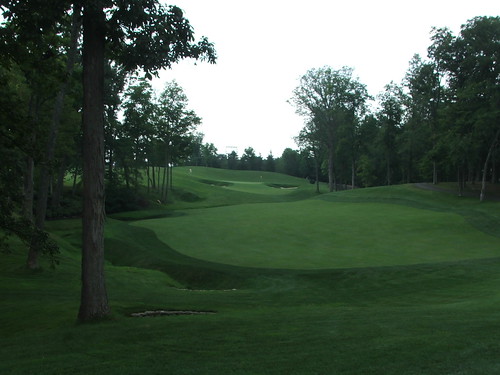
Par five 15th hole playing through a narrow valley
In my view, Muirfield Village deserves to be ranked in the top 100 because it has the best collection of par five holes I have ever seen. It will be Nicklaus's legacy and as such should be treated with respect. He's probably not the first of golf's historical figures I would want to have a beer with, but you have to respect everything he has done for the game. If I may digress, those I would love to have a beer with, in order, are Walter Hagen, Bobby Jones, Tiger Woods, Arnold Palmer and Ernie Els. The ultimate prize, however, would be to have a couple of scotches with Colin Montgomerie because, in keeping with today's theme, he is a psycho. You'd probably have to block out a day and a half to just sit and listen if you just ask him, "Colin, tell me a couple of stories where you argued with people for putting you off your game." I can't wait for next year's Ryder Cup with Monty as captain.
For Columbus, Ohio especially, Muirfield Village is quite formal. There is a guard gate at the entrance like at Pine Valley, and if your name is on the clipboard you are buzzed through the gate. After you drive up to the clubhouse an entourage comes out and greets you by name, and they valet park your car, which is very nice. The people and service at Muirfield Village are first class all the way, and they manage to make you feel at home. They change the spikes in your golf shoes to new spikes to protect their greens, and there is an attention to detail that's 'kinda hokey in a midwestern 'sorta way, but makes a difference. Their wine list is excellent and they have a large selection of Chiantis.
Nicklaus on Muirfield Village, "Certainly it's a tough, tough golf course. But it's a fair test." To keep this comment in context, it is a fair test of golf the same way that swimming from Alcatraz Island to San Francisco is a fair test for a swimmer.
From the back tees, the course plays 7,366 yards and has a slope rating of 149. Be prepared for a stern test of golf if you ever play Muirfield Village and make sure you don't play it by yourself. Go with somebody to lessen your chances of being eaten alive. There's safety in numbers.
Tuesday, September 1, 2009
Whippoorwill Club

I am lucky enough to live within driving distance of thirteen clubs ranked in the world's top 100. I try not to take this for granted, rather, I try to take advantage of it every chance I get, particularly if I can play on weekdays instead of working. It was in this vein that I recently played the Whippoorwill Club in Westchester County, New York.
Westchester County is chocked full of good golf courses. There are the well known ones ranked in the top 100 such as Quaker Ridge and both the east and west courses at Winged Foot. There is the 36 hole Westchester Country Club which hosts PGA tournaments. There are also a whole host of below the radar private clubs built long ago by famous architects during the golden age of course design. A small sample: The Apawamis Club (Willie Dunn, 1899), Blind Brook (Macdonald/Raynor 1916), Century Country Club (Colt & Alison, 1926), Fenway (A.W. Tillinghast, 1924), Old Oaks Country Club (Tillinghast & Alison, 1925), Siwanoy (Donald Ross, 1901, site of the first P.G.A. championship), Sleepy Hollow (C.B. Macdonald and A.W. Tillinghast, 1911), Knollwood Country Club (Tillinghast and Banks, 1921) and the Whippoorwill Club, founded in 1928 and originally designed by Donald Ross with revisions done by Charles "Steamshovel" Banks.

The elegant shingle style clubhouse at Whippoorwill
Whippoorwill took on its most unique characteristics when Banks was brought in and when holes four through nine were built on the west side of Whippoorwill Road. Steep terrain, tree-lined fairways and no parallel holes characterize this section of the course. These holes play in roughly a semi-circle on dramatic, hilly terrain squeezed in between large rocky outcroppings left from the last ice age.
The first three holes play near the clubhouse on open terrain and are very good. All three are dog-leg holes with challenging greens. However, when you cross Whippoorwill Road to the par three fourth hole the course becomes exceptional. They should put a warning sign up near the road crossing as you walk from the third green to the fourth tee that you are entering a unique set of golf holes.

The stretch of holes begins with the fourth, a prototype "Eden" hole and plays 157 yards downhill with dramatic, deep bunkering surrounding it. A shot hit over the green results in serious trouble.
The approach to the green plays uphill with a large, deep bunker protecting the left hand side in the front.
The sixth hole was my favorite on the course, a par five of 538 yards where you also have to hit through a chute of trees into a valley with large rocks on both sides. Your third shot plays downhill to an elongated green that slopes back to front and has a dramatic horseshoe shape in it similar to the green on the third hole at Yeamans Hall.
The sixth hole from behind the green, showing the amazing terrain down the hill
The 8th is a "Biarritz" hole with a big swale in the middle of the very long and tough to hit green.
The eighth green as seen looking back from the 9th tee box
The ninth hole is 379 yards but plays close to 450 since it essentially plays straight uphill. The ninth is known as "Cardiac Hill". The hole is to steep that when you get to the green, you are at the highest point in Westchester County at 740 feet. It is a challenging small, elevated green. The ninth caps off one of the most exciting stretchs of holes a golfer can play and really define the experience at Whippoorwill. I found them exhilirating. A very interesting characteristic of the front nine is the sequence of shots that you have to hit into the greens. The front nine alternates between uphill shots and downhill shots. The 1st hole plays to an uphill green, the 2nd to a downhill, the 3rd to an uphill, all the way through the 10th hole. I don't know if this "roller coaster" effect was by design or by accident, but it creates a nice varied routing.
The back nine has more of the Ross influence and feel to it, although Banks re-did the greens. The back has more open vistas and rolling hills rather than dramatic hills and does not have many of the large rock outcroppings. The course has a nice selection of short par fours that require precision iron shots and good putting such as the 347 yard second hole and the 320 yard thirteenth. While the rest of the course isn't as exciting as holes four through nine, the fourteenth hole stands out as a cracker hole on the back nine. It is a 440 yard par four that plays uphill to the green and has a split fairway, leaving the golfer with a nice strategic choice depending upon how far you hit the ball and the wind. The wild, winding hilly terrain and length make that a par four and half hole on a good day!

Approaching the 14th green at Whippoorwill
Whippoorwill is a fantastic course that, along with Piping Rock, Myopia Hunt Club and the Seaside Course at Sea Island are under-rated courses in the United States. In my view, they are better than several courses ranked in the top 100 such as East Lake, Scioto, Ocean Forest or Medinah. I played Whippoorwill with a learned friend who has also played a lot of good golf courses. We both independently felt that Whippoorwill at times reminded us of Merion. Partly, this has to do with similar terrain in some places and with the general overall short nature of the course. Like at Merion, the course is split in two by a road and you have to be able to hit the ball to the correct side of the fairway or the correct side of the green in order to shoot a good score. A strategy of playing to the middle of the green won't work here due to the green shapes, slopes and severity. You must be on the right quadrent of the green depending upon where the pin is to shoot a good score.
Why is Whippoorwill overlooked and under-rated? Perhaps because the course is only 6,636 yard from the back tees. Perhaps, because it doesn't get much press or outside play given that it is a very private course in a very affluent area. Whatever the reason, I believe the front nine is worthy of cult status. Golfweek Magazine comes closest to recognizing the genius of Banks' work here, ranking the course as #73 in its list of the top 100 classic courses in their 2009 rankings. I have enjoyed all the Banks courses I have played, especially his course in central New Jersey at Forsgate, which has similar green complexes to Whippoorwill and a truly spectacular par five hole (the 8th) that also uses very hilly terrain as artfully as he does at Whippoorwill.
Aside from the great golf course Whippoorwill has a great clubhouse, a nice relaxed feel to it and great caddies. Play it if you ever get invited.
Many thanks to Robert Mercer Deruntz for allowing me to use his pictures of Whippoorwill.
Friday, August 14, 2009
Whistling Straits


Whistling Straits (ranked #53 in the world) is located in Kohler, Wisconsin, about 90 minutes north of Milwaukee. Built by Pete Dye in 1998, it is a beautiful course. If you want to know what it is like to play golf in Ireland but don't want to fly across the Atlantic, Whistling Straits is as close as you'll ever get. The land the course was built on was formerly a U.S. Army base. Owner Herb Kohler instructed Dye that he wanted the course to resemble Ballybunion.
The eight holes that play along Lake Michigan are the most dramatic. Similar to his work at Casa de Campo, Dye does a brilliant job of situating green sites along and above the water. The course is also over-run with bunkering. Many holes have scores of bunkers. Golf Digest estimates there are more than 950 bunkers on the course. That means on average there are 50 bunkers per hole. For basis of comparison, Winged Foot West and Merion East have less than 150 bunkers each on the entire course.
Many of the bunkers don't actually come into play, but they give the course a dramatic and rough and tumble look. The dog-leg right eighth hole is especially noteworthy in this regard. It has a lot of small natural looking bunkers cascading down the hill between the fairway and Lake Michigan.
Like at the Bandon Resort, at Whistling Straits you can only walk, there are no golf carts. This is to maintain the aesthetic in keeping with that of a links course. Cart parts would have ruined the look of the course. The course is full of wonderful little walking paths and natural looking matted down areas that you use to walk from hole to hole, just like in the British Isles.
 The par four fourth hole, "Glory"
The par four fourth hole, "Glory"
The twelfth hole plays only 138 yards and has a big green, but there is a little piece of it close to the water that is isolated from the rest of the green and it's the Sunday pin placement for tournaments. The effective landing area when the flag is set on this side of the green is tiny.

The dramatic par three 17th at Whistling Straits
I stayed at The American Club nearby, also owned by Herb Kohler, the owner of the resort. It is a very nice place and has a great pub. The dining room serves local fare including some great Wisconsin cheese.
Saturday, August 1, 2009
Cherry Hills Country Club

"The shot heard around the golf world" occurred during the epic 1960 U.S. Open held at Cherry Hills. The 1960 U.S. Open featured Ben Hogan, Jack Nicklaus and Arnold Palmer vying for the lead. In the final round, as 'Arnie's Army' watched, Palmer uncorked a 346 yard drive to the par four, 1st green to start the greatest come-from-behind charge in Open history. Palmer moved up 12 players and 7 strokes for a final round 65 and a 280 total for his victory. The 65 was the best final round ever produced in an Open. In addition to the 1960 U.S. Open, Cherry Hills also hosted the event in 1938 and 1978 and the P.G.A. Championship in 1941 and 1985. Among the changes Palmer made to the course was to lengthen the first hole from 345 yards, presumably so no one could drive the green.

The iconic shot of Arnold Palmer throwing his visor after winning the 1960 U.S. Open
Cherry Hills also hosted the U.S. Amateur in 1990, won by 20-year-old Arizona State golfer Phil Mickelson. It will host the Amateur again in 2012. Former NFL great John Elway is a current member of Cherry Hills and the current club champion, with a 1 handicap index.
The Golf Course
The golf course starts on flat ground and the first four holes are relatively straight forward. The green on the 3rd hole, seen below, is new. The hole is 315 yards long but the green is now elevated and difficult to hold as it is crowned and balls not hit precisely will roll off.
The elevation on the course begins at the fifth hole and basically gets progressively more hilly as you play on. The par five fifth hole plays as the #1 stroke index hole at Cherry Hills. The green is elevated, hard to hold and fronted by a swale. The 518 yard hole has interesting terrain and the fairway slopes right to left and the hole dog-legs to the right at the end.

The par five 5th green
The course really begins to pick up steam on the ninth hole. The 434 yard par four ninth hole plays up a big hill back toward the clubhouse. From the landing area of your drive to the green, the hole slopes severely from left to right, following the natural contours of the land beautifully. The difficult green is perched on a slope on this dog-leg right hole.

The dog-leg right, uphill 9th hole at Cherry Hills
The 428 yard par four 10th hole is a mirror image of the ninth except it runs away from the clubhouse and slopes from right to left. They are an excellent pair of holes that use the hilly terrain very well.
Cherry Hills original designer, William Flynn, was also involved in the design or renovations of several other top 100 courses including Shinnecock Hills and the Country Club at Brookline. There are some similarities between The Country Club and Cherry Hills in terms of course routing, the use of large sloping hills in the terrain and the style of approach shots required to get to the green.
The par three twelfth hole of 194 yards plays over water. Cherry Hills has a stream that meanders throughout the property and comes into play often, especially on the back nine.
The par three 12th hole
The thirteenth hole is a 381 yard par four that has a new green. You have to hit over the stream on your second shot to a green that slopes back to front.
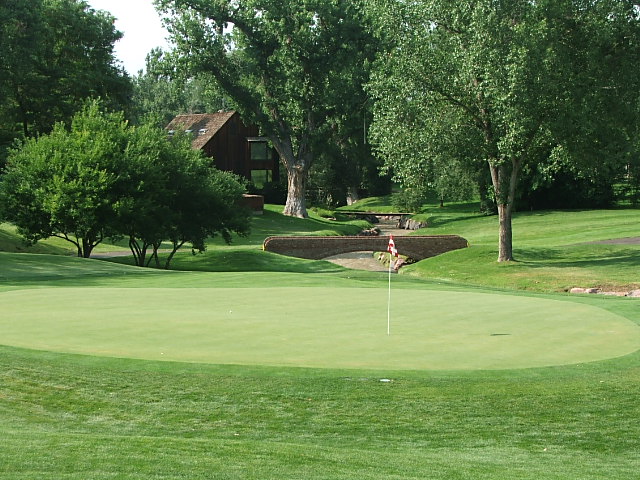
13th green as seen from behind
The fourteenth is a 381 yard par four with another tee shot that you have to hit up onto a big hill. The second shot plays downhill and to the left to a green that has the stream snaking around it and a large tree protecting the left side. It was my favorite hole on the course and presents several good risk-reward decisions on both the tee shot and on the approach shot.

The fantastic 14th hole at Cherry Hills
The par three fifteenth plays 188 yards downhill to a relatively receptive, flat green. Cherry Hills has four sets of tees. The championship tees (which are 'cherry' red) play 7442 yards, the back tees play 6817 yards and the member tees 6400 yards. I like playing a mile in the air because the ball travels an extra 10% further than it does at sea level, so Cherry Hills is not a particularly long course by today's standards once you adjust for altitude. I hit a couple of shots in a less-than-ideal fashion and was yelling for them to get going while at the same time my caddy was yelling for them to get down. That extra 10% helped me more than once.
The par four sixteenth is a good risk-reward hole as well and typifies the back nine, which is much stronger than the front nine. The hole is 402 yards and is a slight dogleg right. Your approach shot plays over the burn/stream to a green set at an angle to the fairway.
The course finishes with back-to-back par fives that both have water in play.
The green on the par five 17th hole
The seventeenth hole is where Ben Hogan famously went for it during the 1960 Open and ended up in the water. The hole is 588 yards and has an island green. The eighteenth hole is a fairly easy par five at 458 yards. It is rated as the #16 stroke index hole, although it plays longer because the hole runs up the hill back toward the clubhouse and the entire landing area is bordered by water on the left, making an accurate tee shot of paramount importance.
The club has nice memorabilia on display in the clubhouse. Dwight Eisenhower had his "summer White House" in Denver and used to play at Cherry Hills where he was a member and at one time served at club president. Ike's heart attack in 1955 occurred after he played a round a Cherry Hills. It actually probably started while he was playing, as he complained of indigestion during the round. There is a nice signed scorecard and other mementos from his tenure in the clubhouse. During Eisenhower's eight years in office he played over 800 rounds of golf. If I'm doing my math correctly, that's almost one hundred rounds a year. This is clearly enough to vault Eisenhower ahead of Ronald Reagan as the greatest president of the 20th century. He had his priorities straight, and was obviously obsessed with golf. I am going to begin a letter writing campaign to the World Golf Hall of Fame to have Ike inducted for this worthy feat.


